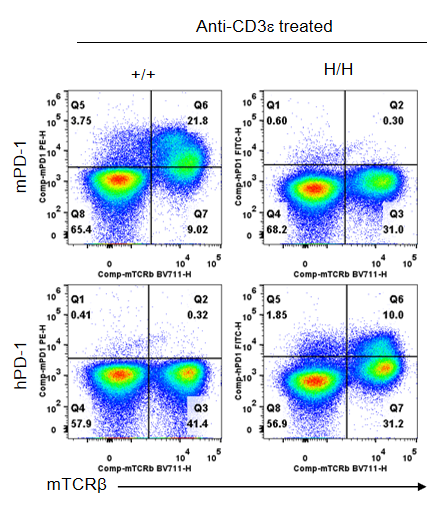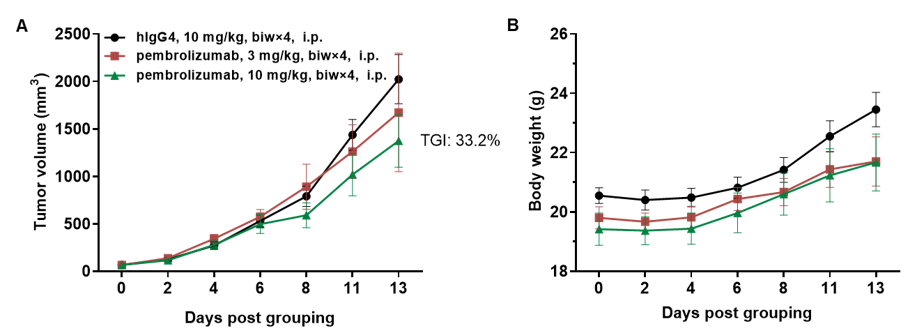中文
B-hPD-1 mice(C)
| Strain Name |
BALB/c-Pdcd1tm1(PDCD1)Bcgen/Bcgen |
Common Name | B-hPD-1 mice(C) |
| Background | BALB/cCrSlcNifdc | Catalog number | 112015 |
|
Aliases |
CD279, PD-1 | ||
模型验证
Protein expression analysis

Strain specific PD-1 expression analysis in wild-type BALB/c mice and homozygous B-hPD-1 mice(C) by flow cytometry. Splenocytes were collected from wild-type BALB/c mice and homozygous B-hPD-1 mice(C) stimulated with anti-CD3ε in vivo (7.5 μg/mice, stimulated for 24 hours, i.p.). Mouse PD-1 was only detectable in wild-type mice. Human PD-1 was only detectable in homozygous B-hPD-1 mice(C).
In vivo efficacy of anti-human PD-1 antibody

Antitumor activity of anti-human PD-1 antibody pembrolizumab (in house) in B-hPD-1 mice(C). (A) Anti-human PD-1 antibody inhibited B-hPD-L1 CT26.WT tumor growth in B-hPD-1 mice(C). Murine colon cancer B-hPD-L1 CT26.WT cells were subcutaneously implanted into homozygous B-hPD-1 mice(C) (female, 9-week-old, n=6). Mice were grouped when tumor volume reached approximately 60-80 mm3, at which time they were treated with anti-human PD-1 antibody indicated in panel. (B) Body weight changes during treatment. As shown in panel A, anti-human PD-1 antibody was efficacious in controlling tumor growth in B-hPD-1 mice(C), demonstrating that the B-hPD-1 mice(C) provide a powerful preclinical model for in vivo evaluation of anti-human PD-1 antibodies. Values are expressed as mean ± SEM.
Copyright © 2024 百奥赛图江苏基因生物技术有限公司. All Rights Reserved
备案号: 苏ICP备2021053911号-1
 苏公网安备:32068402320845号
网站建设:北京分形科技
苏公网安备:32068402320845号
网站建设:北京分形科技
 苏公网安备:32068402320845号
网站建设:北京分形科技
苏公网安备:32068402320845号
网站建设:北京分形科技






 010-56967680
010-56967680 info@bbctg.com.cn
info@bbctg.com.cn